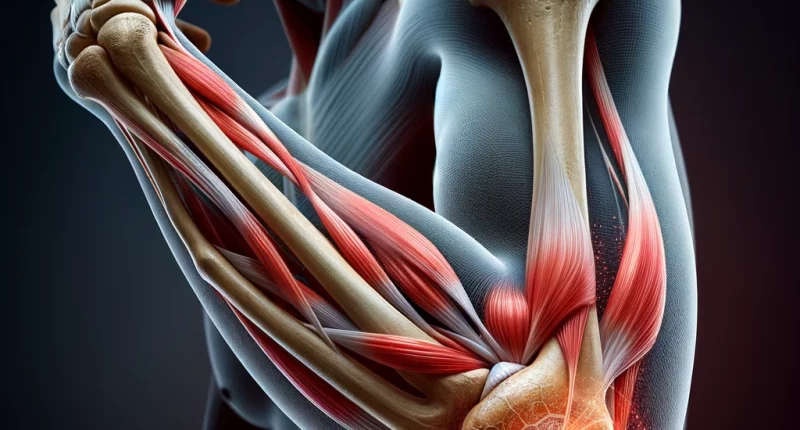Tennis elbow
What’s that?
Tennis elbow, or lateral epicondylitis, is an inflammatory condition that affects the areas of tendon attachment to the bone in the region of either the medial or lateral epicondyle of the shoulder.
About the disease
In the general population, the prevalence of epicondylitis ranges from 1 to 5%, and in a cohort of working people, it reaches 10-15%. The age group of 40-60 years old is the most susceptible to this disease.
In epicondylitis, the pathological process affects the areas where the tendon bundle attaches to the humeral epicondyles (bony protrusions localized near the joints). The lateral form of the disease is characterized by the fact that the tendon part of the common finger extensor is damaged (i.e., the function of finger extension is affected). In the medial form, the tendon part of the common finger flexor is damaged (i.e., flexion in the interphalangeal joints is impaired).
Microtraumatic injuries of tendon bundles predispose to the development of epicondylitis. Against this background, the number of fibroblasts (cells synthesizing collagen and elastin fibers) decreases, connective tissue fibers become disorganized, local blood flow increases, and it acquires pathological features. In epicondylitis, the cartilaginous layer is secondarily involved, aggravating the disease’s clinical picture.
Epicondylitis is characterized by pain in the humerus area closer to the elbow joint. Painful sensations are intensified when this area is felt. Ultrasound scanning and radiography are recommended to establish a definitive diagnosis.
The basis of treatment is a conservative approach. Functional rest of the hand and administration of anti-inflammatory drugs, which may have hormonal activity, are recommended.
Types
There are two types of ulnar epicondylitis:
- with a lesion on the inner epicondyle – golfer’s elbow.
- involving the external epicondyle – tennis elbow.
Symptoms of lateral epicondylitis
The topics of the pathological process determine symptoms of tennis elbow. With the lateral form of the disease, the following signs are present:
- Pain in the outer part of the elbow lasting more than 24 hours in the last week of follow-up;
- Increased pain when feeling the outer surface of the elbow;
- Increased pain in extending the hand is associated with reducing the total extensor of the fingers.
Clinical manifestations of lateral epicondylitis have some peculiarities associated with the pain increasing, not when extending the fingers but actively flexing them. Pain in this form is localized on the inner surface of the elbow. Otherwise, the diagnostic criteria are similar to the lateral form.
Causes of lateral epicondylitis
Inflammation of the inner condyle occurs in patients whose activities involve repetitive bending and twisting of the forearm to the outside. Such stresses are found in golf, baseball, tennis, fencing, and swimming. Occupations involving labor-intensive, repetitive activities that require movements in the forearm, wrist, hand, and fingers are also at risk.
Although lateral epicondylitis is traditionally associated with the game of tennis, in 95% of cases, it is caused by occupational or other daily activities characterized by prolonged monotonous tension on the tendon bundle of the common extensor finger.
Diagnosis
Diagnosis of epicondylitis is based on the analysis of complaints, anamnesis, data of sanitary and hygienic characteristics, results of orthopedic and neurological examinations (taking into account the premorbid background) with the use of instrumental and laboratory methods (radiography, ultrasound, MRI). This approach allows for excluding other elbow pathologies that may manifest similar symptoms.
Recently, ultrasound scanning of the elbow joint has been widely used to establish a definitive diagnosis. Signs indicating pathology include visualization of areas of low acoustic density, inability to trace the course of the tendon, calcium salt deposits, and uneven contours.
Treatment of tennis elbow
Treatment of epicondylitis is performed mainly by conservative methods. Surgery is recommended if this approach is unsuccessful (the result is evaluated within 3-6 months).
Conservative treatment
The main areas of conservative treatment of epicondylitis are:
- functional rest for the sore arm;
- wearing restraints;
- controlling inflammation with non-steroidal drugs or corticosteroids, which can be taken orally or injected topically;
- physical therapy to strengthen the tendon;
In some cases, epicondylitis may resolve on its own. But without treatment, the symptoms may bother a person periodically for two years.
Surgical treatment
Surgical intervention is recommended when the disease symptoms do not regress within 3-6 months of conservative treatment. Surgery for elbow epicondylitis can be performed open or arthroscopically.
Most often, the surgeon performs excision of pathologically transformed tissues in the area of attachment of the causative tendon. After that, the bone bed is reconstructed, and fixation with an aponeurotic component is performed. Modern traumatology favors arthroscopic interventions, as they are minimally invasive, do not traumatize healthy tissues, and have a short rehabilitation period, as well as allow a quick recovery of hand function.
All these treatment options are available in more than 700 hospitals worldwide (https://doctor.global/results/diseases/tennis-elbow). For example, tennis elbow surgery can be performed in 46 clinics across Germany for an approximate price of $4,613 (https://doctor.global/results/europe/germany/all-cities/all-specializations/procedures/tennis-elbow-surgery).
Prevention
Prevention is aimed at preventing tendon injuries. For this purpose, it is recommended to warm up the hands when performing monotonous work with the hand and forearm. Physiotherapy, taping, and massage are also helpful.
Rehabilitation
After surgery, it is recommended to perform physical exercises that focus on the relaxation of the muscle-tendon bundles.

